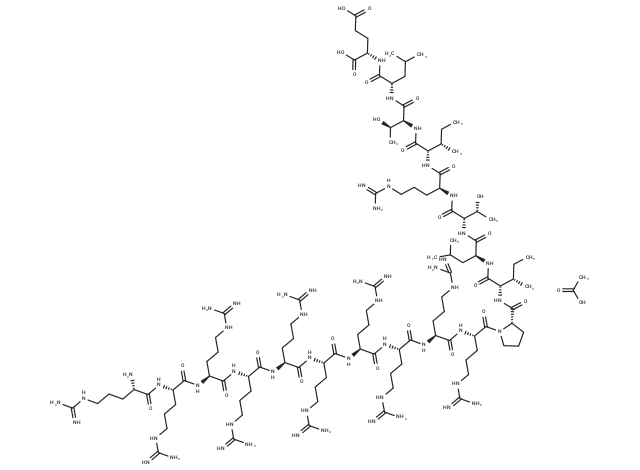Shopping Cart
- Remove All
 Your shopping cart is currently empty
Your shopping cart is currently empty

ReACp53 acetate could inhibit p53 amyloid formation and rescue p53 function in cancer cell lines.

| Pack Size | Price | Availability | Quantity |
|---|---|---|---|
| 1 mg | $55 | In Stock | |
| 5 mg | $160 | In Stock | |
| 10 mg | $235 | In Stock | |
| 25 mg | $393 | In Stock | |
| 50 mg | $560 | In Stock | |
| 100 mg | $762 | In Stock | |
| 200 mg | $987 | In Stock |
| Description | ReACp53 acetate could inhibit p53 amyloid formation and rescue p53 function in cancer cell lines. |
| In vitro | ReACp53 acetate penetrates into HGSOC primary cancer cells and converts mutant p53 from a punctate state into soluble WT-like p53. ReACp53 acetate also induces cancer cell death, cell cycle arrest and results in p53 degradation. ReACp53 acetate specifically affects cell viability and proliferation of cancer cells bearing mutant p53 but not wild type when grown as organoids[1]. |
| In vivo | Only mutant p53-bearing tumors in the ReACp53 acetate-treated mice cohorts are 80-90% smaller in weight than the control cohort, confirming the ability of ReACp53 acetate to limit tumor proliferation and shrink tumors. A significant reduction of Ki67 positive cells is evident in ReACp53 acetate-treated OVCAR3 xenografts, indicative of a reduced proliferative index. Similar results are observed in the minimal residual disease model. In the paradigm, administration of ReACp53 acetate results in a significant increase in p21 and MDM2 transcription in OVCAR3 but not MCF7 xenografts. A significantly increased population is also found in G0/G1 phase, supporting proliferative arrest upon ReACp53 acetate administration in vivo[1]. |
| Molecular Weight | 2677.18 |
| Formula | C110H210N52O26 |
| Smiles | CC[C@@H]([C@H](NC([C@@H]1CCCN1C([C@@H](NC([C@@H](NC([C@@H](NC([C@@H](NC([C@@H](NC([C@@H](NC([C@@H](NC([C@@H](NC([C@@H](NC([C@@H](N)CCCNC(N)=N)=O)CCCNC(N)=N)=O)CCCNC(N)=N)=O)CCCNC(N)=N)=O)CCCNC(N)=N)=O)CCCNC(N)=N)=O)CCCNC(N)=N)=O)CCCNC(N)=N)=O)CCCNC(N)=N)=O)CCCNC(N)=N)=O)=O)C(N[C@H](C(N[C@H](C(N[C@H](C(N[C@H](C(N[C@H](C(N[C@H](C(N[C@H](C(O)=O)CCC(O)=O)=O)CC(C)C)=O)[C@H](O)C)=O)[C@H](CC)C)=O)CCCNC(N)=N)=O)[C@H](O)C)=O)CC(C)C)=O)C.CC(O)=O |
| Relative Density. | no data available |
| Storage | store at low temperature,keep away from moisture | Powder: -20°C for 3 years | In solvent: -80°C for 1 year | Shipping with blue ice. | ||||||||||
| Solubility Information | H2O: 9 mg/mL (3.36 mM), Sonication is recommended. | ||||||||||
Solution Preparation Table | |||||||||||
H2O
| |||||||||||

Copyright © 2015-2025 TargetMol Chemicals Inc. All Rights Reserved.